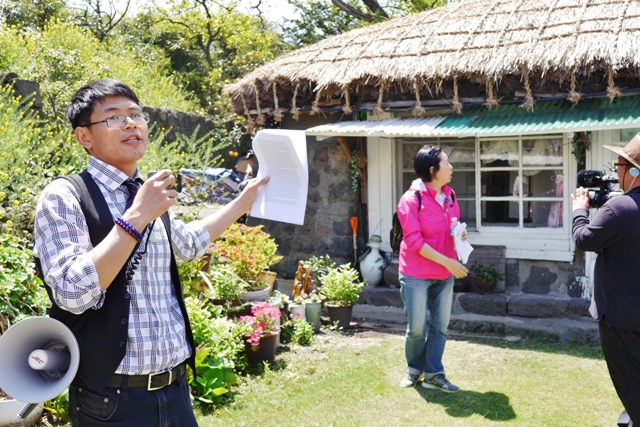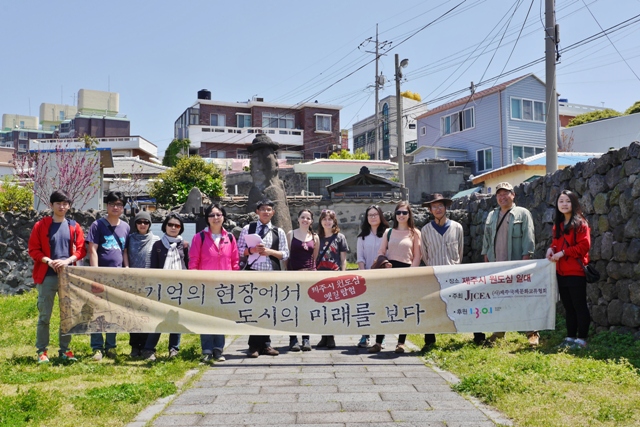| |
 |
|
| Scholar Tommy Tran led the walk around Jeju's old town area with support from Jeju International Culture Exchange Association (JICEA). Photo by Ann Bush |
“Fresh air, sea breezes, and the hidden history of Jeju City. What could be better on a sunny Sunday morning?” reflected Canadian Jeju resident André Goulet after attending the first English-language historical walking tour, "Exploring Jeju’s Old Town Memories" held on April 26.
Goulet’s sentiment captured the warm spirit of the morning as guide Tommy Tran, a UCLA PhD candidate and Fulbright Scholar, told the absorbing history of old Jeju City amid the evergreen and blue pastels of our natural surroundings.
Tran undertakes ethnographic research into the experience of Jeju City's rapid development, and he guided the group from Jeju National Museum, around Sarabong Peak, through Chilseong-ro shopping district, to the old governmental buildings at Gwandeokjeong.
Pausing at many sites along the way, Tran explained a history spanning 1,000 years, including the heavily contested history of Tamna, the ancient Jeju kingdom only fully absorbed by Joseon Korea in the early 15th century.
Attendees learned about Tamna people's shamanistic worldview, creation story, and the arrival of the three brother demigods considered their progenitors. Tran revealed a mythology in which the everyday was intertwined with the divine; pebbles found in rice could portend domestic strife among the gods, and sibling rivalry could lead to cosmic-level disturbance.
Some highlights of the tour included an explanation of the growth of Jeju’s winding and narrow streets — believe it or not, they’ve actually been widened — and the story of Kim Mandeok, a humble, yet wealthy gisaeng hospitality woman who used over 90 percent of her wealth to feed the Jeju people when they faced starvation.
| |
 |
|
| The walk aimed to increase appreciation of Jeju's heritage and boost conservation. Photo by Ann Bush |
We also learned that foreign influence is far from new to the island, with possible Mongolian roots for the dol hareubang (stone grandfather statues), Japanese influence in house construction, and the influence of Chinese refugees fleeing to Jeju from the civil war which ended in 1950, establishing many of the Chinese restaurants in the old town.
Nevertheless, this long, abounding history doesn’t do much to ameliorate the worries caused by the current David-and-Goliath fight to safeguard Jeju’s old structures in the face of rapid development and globalization.
Indeed, the utter transformation of Jeju in the past few decades inspired the original Korean-language tour given by Jeju National University professor Ko Young-lim, chairperson of Jeju International Culture Exchange Association (JICEA) that sponsors both tours.
Ko was compelled to start JICEA after seeing old structures being torn down for new development. Hoping to increase appreciation for Jeju’s historical heritage, Ko herself helped save a 100-year-old house from demolition and often visits her nonagenarian aunt who lives in a 300-year-old thatched-roof house. In fact, tour attendees had the pleasure of viewing this awe-inspiring structure and meeting its charming elderly occupant, who spoke to us in Japanese once she realized we were foreigners.
Both Ko and Tran see the urgency of protecting Jeju history and correcting misinformation generated by a tourism industry haphazardly filling in the blanks to create a readily marketable narrative.
This historical tour through old Jeju exposed the absurdity of manufacturing a false history when the reality is so rich, a history in which Jeju people fought so hard to defend their way of life, only now to be up against the forces of globalization.
This English-language tour can be seen as part of a larger effort to garner global interest and participation in heritage conservation, and also to establish a more meaningful, less superficial English narrative on Jeju history. Tran laments the “huge absence of meaningful English literature in Jeju” which not only motivated him to lead these tours, but also pursue his academic research.
| |
 |
|
| JICEA chair Ko Young-lim holds both Korean and English language tours around the city. Photo by Ann Bush |
Ostensibly taken as a wholesome and educational Sunday excursion, this tour in fact plays a meaningful part in the struggle to prevent development from steamrolling over Jeju heritage.
As Ko sees it, “We must take an active role in preserving the ancient aspects of Jeju in order to fulfill the vital mission of giving future generations our legacy of living memories.”
Contact Ko Young-lim of Jeju International Culture Exchange Association (JICEA) at koylim@naver.com |






















